SanDisk Ultra II (240GB) SSD Review
by Kristian Vättö on September 16, 2014 2:00 PM ESTRandom Read/Write Speed
The four corners of SSD performance are as follows: random read, random write, sequential read and sequential write speed. Random accesses are generally small in size, while sequential accesses tend to be larger and thus we have the four Iometer tests we use in all of our reviews.
Our first test writes 4KB in a completely random pattern over an 8GB space of the drive to simulate the sort of random access that you'd see on an OS drive (even this is more stressful than a normal desktop user would see). We perform three concurrent IOs and run the test for 3 minutes. The results reported are in average MB/s over the entire time.
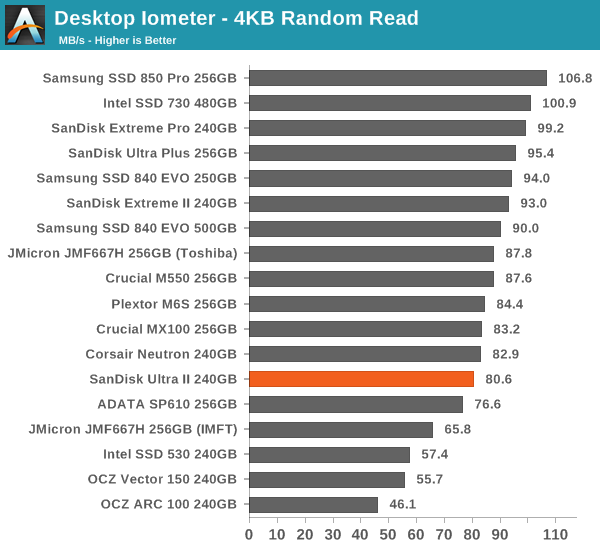
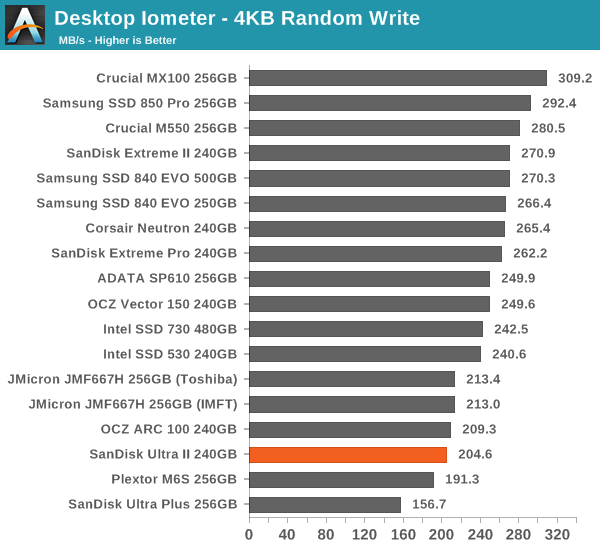
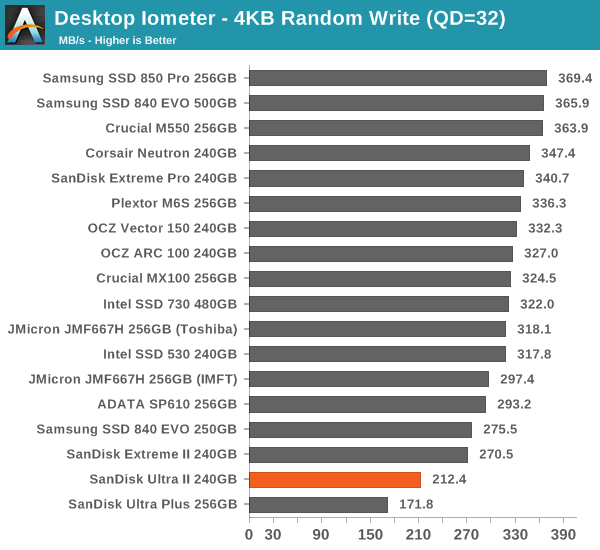
Random performance is decent but not overwhelming. I am surprised that the Ultra II is not faster considering the SLC cache that nCache 2.0 provides. Random write performance especially is a bit slow by today's standards and does not scale with queue depth, but for light client usage the Ultra II should still be fine.
Sequential Read/Write Speed
To measure sequential performance we run a 1 minute long 128KB sequential test over the entire span of the drive at a queue depth of 1. The results reported are in average MB/s over the entire test length.
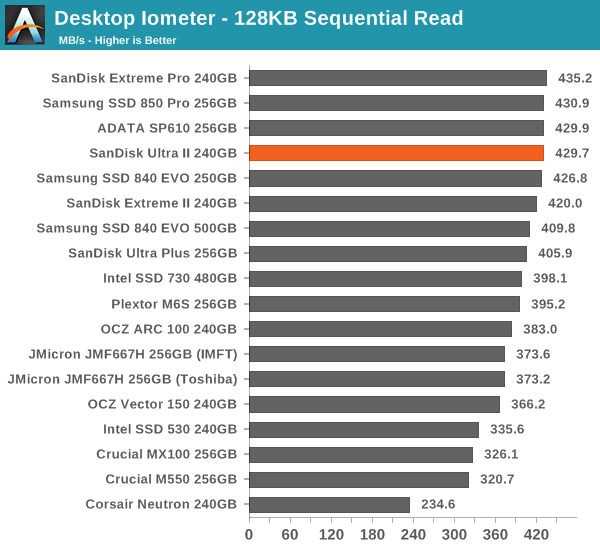
Fortunately sequential read performance is much better, although sequential write performance gets handicapped due to TLC, similar to the 840 EVO.
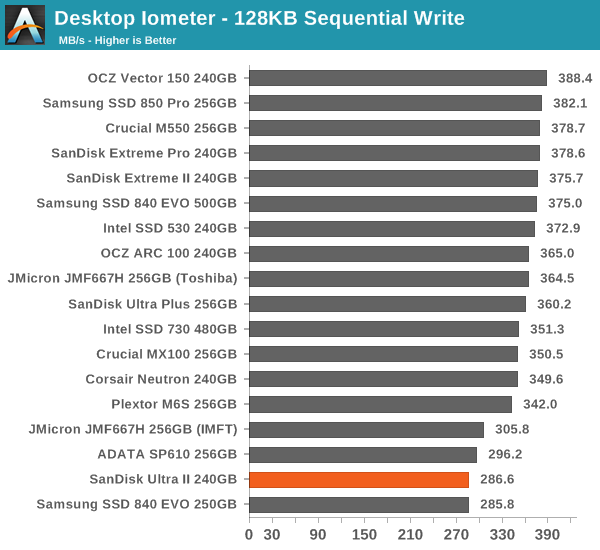
AS-SSD Incompressible Sequential Read/Write Performance
The AS-SSD sequential benchmark uses incompressible data for all of its transfers. The result is a pretty big reduction in sequential write speed on SandForce based controllers, but most other controllers are unaffected.
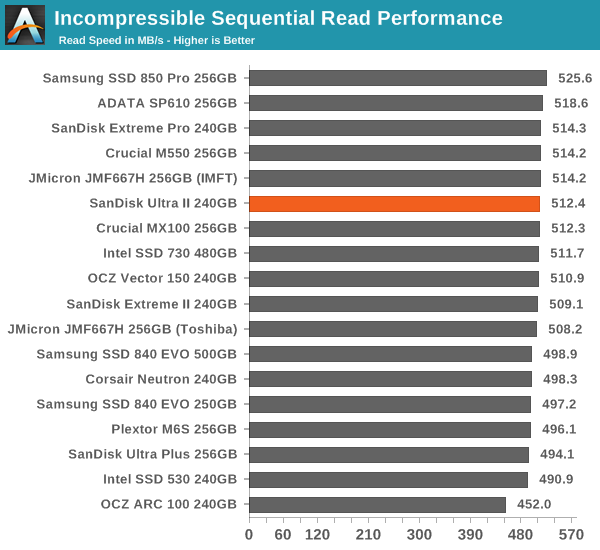











54 Comments
View All Comments
coder111 - Thursday, September 18, 2014 - link
I think we can safely assume any off the shelf/factory based hardware encryption has backdoors by NSA/GCHQ or Chineese intelligence or whoever. So it doesn't protect from governments nor government sponsored industrial espionage. In the best case it protects from information leaks in case of casual theft. At worst, it gives a false sense of security.I would never rely on anything except open-source encryption where the source is continuously being reviewed. And even that is can be compromised by introducing hard to detect bugs.
So I don't think hardware encryption support adds much value if any.
jabber - Wednesday, September 17, 2014 - link
Can we just cut the reviews for SATA based SSDs down purely to "What makes this SSD radically different to 99% of the similar performing SSDs out there"? Would just save a bit of time that's all. SSDs are now like RAM, all much of a muchness and we just need to know the bells and whistles if any.Kristian Vättö - Wednesday, September 17, 2014 - link
SSDs are way different than RAM is. RAM is managed by a controller that is integrated to the CPU, so the DRAM you buy is basically a bunch of dummy silicon with no logic in itself. If SSDs were just a stick of NAND, then you would be correct, but the truth is that SSDs have a controller and firmware, which makes one SSD different from the other. In addition, NAND is much more complex to manage compared to DRAM because you have all sorts of limitations (page is the minimum write and you can only erase blocks etc.), so there is much more to it than with RAM, which is basically just differently binned pieces of DRAM silicon.We could drop all component reviews if we took your mindset because current computers can do pretty much everything that average users want them to do. However, the fact is that there are people who are interested in the details and how things work, and there are people who do more than just web browsing and email, so that is where detailed reviews are needed.
Powerlurker - Sunday, September 21, 2014 - link
StorageReview basically stopped reviewing consumer-grade drives for most second and third tier manufacturers because they got tired of writing reviews that said, "Yep, it's another Sandforce reference design, and it pretty much performs the same as all the others."milli - Wednesday, September 17, 2014 - link
I feel that Anand is praising the MX100 just a little bit too much. I had to first hand experience that it's not that good (even for a budget drive). Those bad service times you measure on the MX100 are really noticable in real life usage.In my case, five identical i5 machines. Four with 256GB MX100 drives. One with a PNY 240GB Optima (was even cheaper than the MX100). During heavy work, the machine with the Optima was clearly snappier. And I don't mean I measured higher MB/s but snappier. Everything you open just starts to happen/load a little sooner.
This shows that your reviews for low-end consumer SSDs are too workstation/server minded. The fact that the MX100 start being faster than the Ultra II after a barrage of 10GB of random data, means basically nothing for a casual desktop user. The usual desktop usage is small burst of data. Lots of idle time. You want those burst to happen/start fast.
You keep pushing encryption as a pro (and it is one) but keep in mind that probably less than 1% of people actually use it.
My advice? Both the M500 and MX100 are laggy. Drives with Phison controllers are laggy. Transcend SSD 340 (JMicron) felt laggy like the M500.
PNY Optima didn't feel laggy. Sandisk Ultra Plus didn't feel too laggy either (not perfect though).
I'm eager to test the Ultra II and the Hynix SH910A (because the Neutron felt so smooth).
I don't know how you're going to measure this through benchmarks (well the service time one seems to show it) but my brain surely is perceptible to this.
hojnikb - Wednesday, September 17, 2014 - link
I smell bullshit or defective drives. There is no way, mx100 or m500 for that matter would fell as laggy as phison or jmicron for that matter. Both of those controllers are far inferior to marvell offering. In fact, some older jmicrons and phisons are so bad, that it doesn't even take a heavy user to notice the difference or lag.milli - Wednesday, September 17, 2014 - link
Yes, true. I've got dozens of broken drives. ;) Seriously, no bullshit.Obviously I'm talking about drives with JMicron and Phison controllers from 2014 and not the older ones.
Also with laggy I don't mean that I'm waiting seconds, right! As an enthusiast and professional of plus 20 years, a couple fractions of a second make them feel more laggy to me.
hojnikb - Wednesday, September 17, 2014 - link
Well, considering the workload you have, why didn't you go with more expensive drives in the first place ?I mean, those drives are not exactly meant for heavy work you're describing.
MrSpadge - Wednesday, September 17, 2014 - link
If one of them does it significantly better than the others, that's something worth noting. Especially if it doesn't show in the benchmarks we're used to looking at.milli - Wednesday, September 17, 2014 - link
Very true what you say but the clients these machines are meant for, use it for light usage. It's only during preparation of these machines that I notice the differences. The only reason I used the MX100, is because of Anand's recommendation. At first I was skeptical about it because of the M500. It seems that skepticism was just. There are better client usage cheap drives out there.